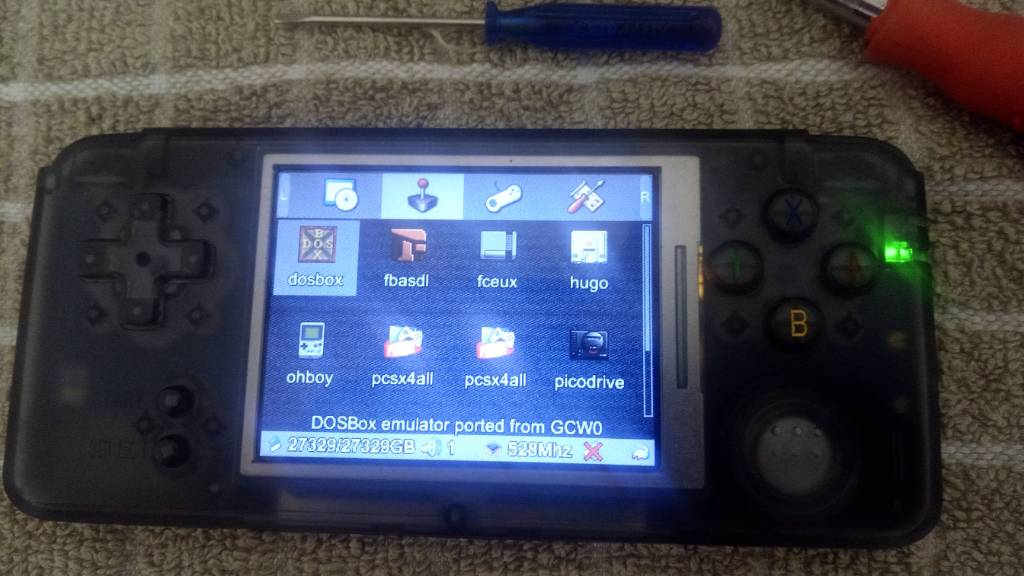yeah, the ESP32 is pretty fast (240MHz), and slower bitboxes (STM32F4 at 168 MHz) race the beam to output a VGA signal. i have zero experience with writing to LCDs, but yeah, there are combo-packs out there for the ESP32:
https://www.adafruit.com/product/3384
i'd love it to become a "dumb phone," as well, actually, if i can have my pie in the sky and eat it too. i suppose i should start small, though. and wait 'til the kids are old so i have more time.
i could wait for the next RISC-V MCU, too. (the last one was 320 MHz but low on RAM.) i could save up and then "pay a guy" who knows how to "fix my problems."
The STM32F4s etc have no problem emitting VGA; you don't need all that many MHz to emit it, really. (I was doing it before the bitbox, and I was going to release a kit.. but small kids and lazy, never got around; then he cleaned up that space, so good for him

.. The STM32 architecture does have some issues which make it challenging.. in my experience, the way the various bus mesh together, means that when you're trying to hit your GPIOs to drive out the VGA signal, you're tieing things up quite a bit. ie: You have plenty of mhz to drive h4e VGA, with quite some left over .. but you can't communicate out of the chip much, since you're driving the GPIOs pretty much full tilt (GPIO has a change latency, so you can't just drive them full speed .. they are necessarily slower than the cpu core itself), and communciating across the bus to the GPIOs as well; and everythign else in the chip has to communicate across those busses; there are several busses at play and several separate RAM regions .. on the bitbox, I seem to recall they are streaming the VGA with a small line buffer (ie: generating a line or two ahead, and the VGA IRQ is pumping out from the last buffer; like a small ring buffer, like audio is done.) The approach I was using was to keep mostr of the device RAM as framebuffer, and let the IRQ pump from that. So I had almost no RAM frtee for general processing (but I had extrnal ramn and anotehr cpu, since I wanted rthe STM32 as a GPU, not as the whole thing, which I did as well..); anyway, so if you're streaming just a little data out, and you're doing the rest of your processing inside, you have no problem -- no need to work the other GPIO or peripherals too much (except audio, which is fairly forgiving in this context). In my case, though, I hd a z80 or 68000 or 6502 as a cpu, driving data over the system bus and external RAM, to the STM32 as GPU; and there was the trouble.. the STM32 had plenty of time left over after doing VGA IRQs, but I coudl only use the GPIOs at hsync and vsync/vblank times, since trying to get at the other GPIOs coherently, while also driving VGA, was really trouble/tricky (timing intensive.) Anyway, without boring you to tears, the STM32 have _plenty_ of CPU left over after driving VGA.
The ESP would have even more; I'm not sure how decent its GPIO handling are, but as a standalone.. remember that the old GP32 and such were slower, and they did okay

jeff
[doublepost=1518621109,1518620817][/doublepost]
I'd say I'll use a Wiz.
Why do you say that cross-compiling software for it is problematic ?
I mean in the sense where .. few peopel are using them anymore, the community is small (was always smallish); mostly I mean .. my old VM for Wiz melted down, which makes me sad

(I used to keep a separate VM for each main platform, so I could spin up any number of VMs from archive, and always have a good working build env; I used ot be That Guy and check the toolchain, compilers, kernel, the whole shbang into code repo, so I coudl check out the whole thing and build a new VM quick, too. But I didn't for wiz and PSP and I can't be bothered to track down all the SDK and build a tollchain. ED has kept up the main file archives though so at least most of the software is still around, but ehhh.)
But yeah, I still use the Wiz, PSP Slim and of course Pandora; I'm afraid the kids will trash the Pandora so it tends to staty out of sight, so if I want to goof off while putting them to bed, or more accuratel;y.. dig out a device to fire up a game on and let the kids take it, its Wiz or PSP .. they can take a good beating and at least with PSP, can be replaced for $50




